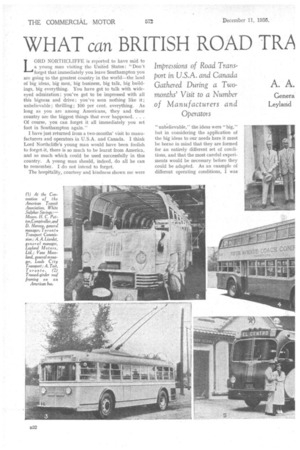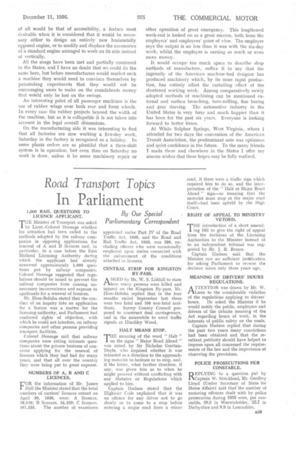WHAT can BRITISH ROAD TRA SPORT LEARN from AMERICA?
Page 50

Page 51

Page 52

Page 53

If you've noticed an error in this article please click here to report it so we can fix it.
LORD NORTHCLIFFE is reported to have said to a young man visiting the United States : "Don't forget that immediately you leave Southampton you are going to the greatest country in the world—the land of big ideas, big men, big business, big talk, big buildings, big everything. You have got to talk with wideeyed admiration: you've got to be impressed with all this bigness and drive : you've seen nothing like it ; unbelievable ; thrilling ; 100 per cent. everything. As long as you are among Americans, they and their country are the biggest things that ever happened. . . . Of course, you can forget it all immediately you set foot in Southampton again."
I have just returned from a two-months' visit to manufacturers and operators in U.S.A. and Canada. I think Lord Northcliffe's young man would have been foolish to forgeta, there is so much to be learnt from America, and so much which could be used successfully in this country. A young man should, indeed, do all he can to remember. I do not intend to forget.
The hospitality, courtesy and kindness shown me were "unbelievable," the ideas were "big," hut in considering the application of the big ideas to our needs here it must be borne in mind that they are formed for an entirely different set of conditions, and that the most careful experiments would be necessary before they could be adapted. As an example of different operating conditions, I was much impressed with the almost universal operation of tractors with automatic detachable trailers, the latter having small Wheels so arranged close to the portion attached to the tractor that when the trailing unit is withdrawn they contact with the ground and support the trailer for loading and unloading purposes.
The type is on the British market toe, but for home use they have -to conform to stringent regulations of weight, dimensions and, above all, speed, instead of .bowling along at 50-60 m.p.h., whilst their use with a second normal trailer, making a road train, would be definitely illegal here. The American finds that such an outfit offers the most economical pay-load, all the more effective because of the greater mobility that he appears to manage to extract from his tractors.
Local passenger services provide another example of varying conditions and outlook. In several places trolleybuses are replacing.tramcars, but in general the tram appears destined to linger longer in the States than here. The systerns'tre so large, frequently extending, on high-speed tracks, well beyond the cities, and they still serve admirably the purpose for which they were originally built. New trams with specially constructed power bogies are at present 'being produced in fairly large numbers. The rim and tyre of the wheel are mounted on the hub through the medium of heavy rubber discs. Cones of rubber are also used instead of springs. This design has made the operation of the tram practicaly noiseless. Its reliability after prolonged service has, I think, yet to be established.
Many enthusiastic operators of oil engines here have wondered at the apparent slowness of the Americans in adopting this type of unit. At the moment few are actually operating in the States, and those only experimentally, due chiefly to the fact that the petrol engine is made in such large quantities by specialist builders that it can be offered at a very low price, whilst in contrast, the small quantities in which the oil engine is being turned out make the discrepancy between the two prices much greater than here.
Variations in Price of Fuel.
Then, too, whilst the price of petrol varies greatly in the different States, it usually approximates closely to that of oil fuel, so that the only saving in oil-engine operation is the actual running economy. As yet no facilities exist for the distribution of oil fuel, and operators have a general notion that all oil engines are rough, noisy, smoky and smelly, so that they hesitate to introduce them to a public accustomed to a silky, wellmannered petrol engine.
But if the off engine has not yet come to stay a large number of manufacturing concerns is experimenting with it and making considerable progress. In the meantime, experts forecast to me that the use of oil engines will not develop materially in the States during the next two years, and any development during that period will be in the bus and not the truck field.
Disturbingly, however, they forecast the immediate entry of the country into the oil-engine export market, with units of a capacity as low as four litres upwards, so that British manufacturers may anticipate competition froin medium-light oil-engined American trucks both overseas as well as in the British Isles.
Probably the most instructive aspect of American operation, both for the British user and manufacturer, is the use of public service vehicles with what are, to us, unorthodox engine positions. The conventional bonneted type of passenger machine is no longer manufactured, and a full-fronted front-entrance vehicle with a flat floor extending its full length has almost entirely superseded it. The engine is housed either centrally beneath the floor or, with the gearbox, at the rear.
I have a very sbong impression that the transit-type machine, as it is called, has found popularity purely on the crest of a fashion wave in the States, stimulated by an appreciation of the attractive appearance that is undoubtedly obtained. In any case, like all American buses, it is intended for one-man operation, even at rush hours when overloading has practically no limit, and from this angle it does offer practical advantages, being capable of carrying more "standees."
British operators, on the other hand, under the compulsion of the less ethereal considerations of Ministry of Transport requirements, will be more inclined to ask "Flow much more shall I earn per mile by using this vehicle?"
It is difficult to answer that more can be earned. If seating capacity were the only criterion, the rear-engined bus would be ruled out, because it gives only the same number of seats as do our forward-control machines here. Since the makimum amount of space is required around the engine to assist cooling, it is not possible to arrange seats over it ; American designers provide a definite partition between the saloon and the "engine room," often fitted with a window so that the .curious may "see the works." The under-engined bus would give a few extra seats.
Both types would make a lighter machine, although the Americans build bodies so heavy that comparative figures would convey nothing. Rear-engined buses, popularly termed '' pushers," lend themselves more readily to the combined construction of body and underframe without the use of chassis side members, as all reactions of the drive are confined to the rear cradle housing the engine and gearbox. This tends to give a lighter vehicle than the under-engined type, on which the reaction of engine and drive is similar to our normal construction, so that side members are used, but of much slenderer dimensions than we find it necessary to employ. In any case, one visualizes with distaste sending to bodybuilders a series of loose units instead of a chassis.
The outstanding advantage of the rear-engined machine, at any rate over its under-engined rival, appears to be that of greater accessibility ; moreover, it lends itself easily to production in the form of a trolleybus, or, as is still being produced in the States, a petrol-electric bus. Another claim made on its behalf is that it gives a scientific weight distribution of one-third on the front axle and two-thirds on the rear, as against the fifty-fifty distribution of an under-engined product. To my mind, however, the transmission complications and, above all, the seating capacity obtainable, rule the type out of practical politics in this country.
Criticisms of the Under-engined Machine.
But the under-engined machine, too, would need most careful attention before it could be suited to British requirements. Far more vibration than on a forwardcontrol type might be transmitted to the passengers, who might also be troubled with a smell from the engine when idling. These disadvantages apply more seriously to the use of an oil engine in this position. It would be difficult to keep road mud and dirt from the engine, and cooling would be a problem. The greatest question of all would be that of accessibility, a feature most desirable when it is considered that it would be necessary either to design an entirely new horizontally opposed engine, or to modify and displace the accessories of a standard engine arranged to work on its side instead of vertically, All the snags have been met and partially countered in the States, and I have no doubt that we could do the same here, but before manufacturers would market such a machine they would need to convince themselves by painstaking experiments that they would not be encouraging users to make on the roundabouts money that would only be lost on the swings.
An interesting point of all passenger machines is the use of rubber wings over both rear and front wheels. In every case the rubber projects beyond the width of the machine, but as it is collapsible it is not taken into account in the legal overall dimensions.
On the manufacturing side it was interesting to find that all factories are now working a five-day week, Saturday in the factory is recognized as a holiday. In some plants orders are so plentiful that a three-shift system is in operation, but even then on Saturday no work is done, unless it be some machinery repair or
other operation of great emergency. This lengthened week-end is looked on as a great success, both from the employers' and employees' point of view. The employer says the output is no less than it was with the six-day week, whilst the employee is earning as much or even more money.
It would occupy too much space to describe shop methods of manufacture, suffice it to say that the ingenuity of the American machine-tool designer has produced machinery which, by its more rapid production, has entirely offset the curtailing effect of the shortened working week. Among comparatively newly .adopted methods of machining can be mentioned external and surface broaching, turn-milling, fine boring and gear shaving. The automotive industry in the United States is very busy and much happier than it has been for the past six years. Everyone is looking forward to better times.
At White Sulphur Springs, West Virginia, where I attended for two days the convention of the American Transit Association, the predominant note was optimism and quiet confidence in the future. To the many friends I made there and elsewhere in the States I offer my sincere wishes that these hopes may be fully realized.




































































































